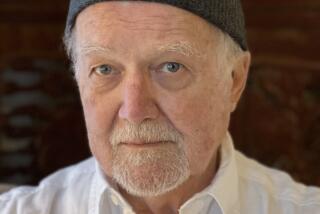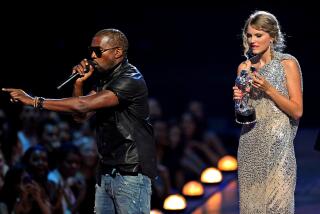A delicate look at a prickly man
Literary biographies are a bulimic business. The writer packs down as much life as he can in his books; the biographer tries to force it back up. No one expected V.S. Naipaul, the tetchiest writer alive, to submit to this kind of indignity. But seven years ago, shortly after winning the Nobel Prize, he granted Patrick French unrestricted access. The result is an unflinching account of the 20th century’s unlikeliest literary giant. Part tragedy, part comedy, part murder confession, “The World Is What It Is” has outraged the British press. And that is just how Sir Vidia likes it.
Naipaul was a post-colonial writer before that label was a gleam in the academy’s eye. In 1950, he won a scholarship that took him from Port-of-Spain, Trinidad, to University College, Oxford. There he read English, met his first wife, Pat, and began writing comic novels about Trinidad. “In order to become a writer, that noble thing, I had to leave,” Naipaul tells French. “In order to write, I had to go back.”
With “A House for Mr. Biswas,” Naipaul expanded the franchise of the grand 19th century novel to include people previously off the map. The novel shows off a talent for characterization on par with the best of Twain and De Maupassant, and alongside Moses Herzog, Prince Fabrizio and Timofey Pavlovich Pnin, Mohun Biswas stands in the lineup of the most memorable characters in postwar fiction.
--
Post-colonialism
Naipaul’s contradictions were already on display at Oxford. He knew he belonged to the first tide of ex-colonials to hit postwar England, but he wanted to set himself apart. He believed the long history of oppression had damaged Africans, Indians and the people of the Caribbean, but he exempted himself from the cycle of resentment.
By the time post-colonial movements were gaining momentum in the 1960s, Naipaul was skeptical of their healing power. He never embraced any elite, English or otherwise. “I have got to show these people that I can beat them at their own language,” Naipaul wrote to his sister, Kamla, from Oxford. His letters reveal a deep-seated paranoia about being “done down” -- by his teachers, his agents, publishers and his champions.
Sometimes he was right. Evelyn Waugh, who praised Naipaul’s work in public, expressed insulting views of him in private. Part of Naipaul’s way of coping with such undercurrents was to become a caricature of a racist himself. “Africa has no future,” he liked to remark, and India was a nation of defecators. The Caribbean, which he revisited during its richest literary period for his anti-travel book “The Middle Passage,” was a chain of mediocrity. Naipaul shored up his sense of dignity with a generous contempt for anything relating to his origins.
For the writer’s real cruel streak, French takes us closer to home. Naipaul’s first wife, Pat, functioned nearly as his butler. After 40 years of abuse, she learned in the New Yorker that her husband had frequented prostitutes in the early days of their marriage. She was also devastated by his long affair with his Argentine mistress, Margaret Gooding. But French suggests it was Naipaul’s routine acts of cruelty -- his discouragement of Pat’s acting, writing, even her gardening -- that really did her down. “It could be said that I killed her,” he tells French, as if her demise were a side effect of his art.
Alternating between Margaret and Pat, French shows the two women playing to the opposing sides of Naipaul. With Pat, he felt comfortable discussing literature, while Margaret consumed the adventurous side of Naipaul, who felt he never had been properly trained in sexual technique. One English reviewer suggested Pat and Margaret were as useful to Naipaul “as his pencils and pens,” but French makes the convincing case that each had more than an instrumental hand in Naipaul’s lurid descriptions of sex.
For more than 50 years, Naipaul has aggravated the literary world with his broadsides on liberal pieties. French attributes part of the venom to Trinidadian “picong,” a joyful teasing that takes pleasure in outrage. Naipaul can be deadly in conversation. “It was not a meeting of minds,” he says of his relationship with Margaret. Naipaul called the fatwa against Salman Rushdie “an extreme form of literary criticism.” He pronounces the last name of his nemesis Edward Said as if it were the past participle.
--
Lost in the world
But we read Naipaul for the prose, not the provocations. Naipaul never abandoned the spare style he inherited from his newspaperman father. He absorbed some of the lessons of literary modernism but never dabbled in experimentation in style. The title of French’s book comes from “A Bend in the River,” in which Naipaul writes, “The world is what it is; men who are nothing, who allow themselves to become nothing, have no place in it.”
That beautifully punishing sentence captures Naipaul and his favorite subject. Whether it is Mr. Biswas reading Marcus Aurelius on his Slumberking bed or the Bombay servant stranded in Washington, D.C., in “One Out of Many,” Naipaul has written of men who have lost their place in the world. His characters make painfully bad choices, and his refusal to push them toward neat climaxes makes them feel undeniably real.
It’s a testament to French’s delicate skill that instead of trying to puncture Naipaul’s well-tested armor he shows how the plates lock together. Naipaul’s statements about Pat seem like a bid to seal his reputation for candor, but French exposes just enough of this disingenuousness to make “The World Is What It Is” the best account of Naipaul we are likely to get. As one Rasta poet put it, “He’s a living example of how art transcends the artist ‘cos he talks a load . . . but still writes excellent books.”
Time, it seems, has already pardoned V.S. Naipaul for writing well.
--
More to Read
Sign up for our Book Club newsletter
Get the latest news, events and more from the Los Angeles Times Book Club, and help us get L.A. reading and talking.
You may occasionally receive promotional content from the Los Angeles Times.









